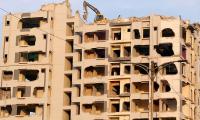LAHORE:A thick layer of smog engulfed the provincial metropolis here Sunday blurring the vision and causing serious health problems for the citizens as the Air Quality Index (AQI) reached over 400.
The sudden increase in smog has raised serious questions over the performance of the Environmental Protection Agency (EPA) and Environmental Protection Department (EPD), which seemed to fail in the implementation of SOPs to counter smog.
Sources in EPA revealed that a number of furnaces and other industrial units in several areas in the City were still operating at night and using sub-standard fuel such as rubber tyres, plastic and other materials while many other industries in different industrial estates in the City were also contributing to rising air pollution.
Sources said that a very half-hearted campaign was started against smoke-emitting vehicles and EPA’s claims of using safe city cameras to take action against smoke-emitting vehicles was just a statement.
Environmentalists said the increase in fine particles (PM2.5) was the main cause of reduced visibility (haze) due to which many citizens were feeling irritation in eyes and difficulty in breathing and irritation in throat followed by cough.
As per the official report released by EPD on its website, the AQI level in the City on Sunday at Karol Ghatti, China Scheme was 402. This was the only area from where the department released data of PM2.5, which was the main contributor of the smog.
Sources in EPD claimed that the air quality monitoring van of the department was out of order for the past two/three days and that was why data of PM2.5 was not collected from other areas of the city.
It is pertinent to mention here that the department has so far completely failed to install permanent monitors in main city localities to calculate/monitor the PM2.5 in air quality. Insiders said that EPA has only one mobile van, which can monitor the level of PM 2.5 while rest of its eight fixed stations in the provincial metropolis were either non-functional or were not able to detect PM 2.5. Health experts said that the size of particles was directly linked to their potential for causing health problems. Small particles less than 10 micrometers in diameter pose the greatest problems, because they can go deep into lungs and some may even get into bloodstream.
“Exposure to such particles can affect both lungs and heart,” said Dr Tariq Chishti, a general physician. He said numerous scientific studies had linked particle pollution exposure to a variety of problems, including premature death in people with heart or lung disease, nonfatal heart attacks, irregular heartbeat, aggravated asthma, decreased lungs function, increased respiratory symptoms, such as irritation of the airways, coughing or difficulty breathing.
He advised that people with heart or lung diseases, children and older adults were the most likely to be affected by particle pollution exposure and they should remain indoor during smog season.
On the other hand, the scribe called Secretary EPD but he didn’t attend the phone. A text message regarding the story was also sent to him but he didn’t reply till filing of the report.
Meanwhile, Met officials said a westerly wave was affecting most upper and western parts of the country and may persist till Monday. They predicted that rain-wind/thunderstorm (snow over hilly areas) was expected in Kashmir, Gilgit-Baltistan, Khyber-Pakhtunkhwa, Upper Punjab and Balochistan while dry weather was likely in other parts of the country.
Rainfall was recorded at several cities, including Cherat, Balakot, Kalam, Patan, Mir Khani, Kakul, Dir, Peshawar, Parachinar, Bannu, Buner, Darosh, Chitral, Takht Bhai, Saidu Sharif, Malam Jabba, DI Khan, Joharabad, Gujrat, Mandi Bahauddin, DG Khan, Mangla, Jhelum, Sialkot, Narowal, Islamabad, Chakwal, Hafizabad, Gujranwala, Murree, Sargodha, Layyah, Nurpur Thal, Bhakkar, Kotli, Muzaffarabad, Rawalakot, Garhi Dupatta, Astor, Bagrot, Gupis and Chaman. Sunday’s minimum temperature was recorded at Leh and Kalam where mercury dropped to 0°C while in Lahore, it was 16.2°C and maximum was 28.2°C.
Minister for Mines & Minerals Sardar Sher Ali Gorchani seen in this image on April 1, 2024. — Facebook/Sardar Sher...
This photograph shows students attending a class at a school on the outskirts of Lahore. — AFP/FileLAHORE:Department...
Lahore Waste Management Company workers cleaning the streets. — APP/FileLAHORE:Lahore Waste Management Company has...
UHS Vice Chancellor Prof Ahsan Waheed Rathore sits during a meeting. — X/@uhslhrofficial/File LAHORE:The 79th...
This image shows Punjab police personnel standing alert. — AFP/FileLAHORE:On the instructions of Director General...
Representational image showing dark clouds. — PPI/FileLAHORE:Partly cloudy weather with hot and humid conditions was...







